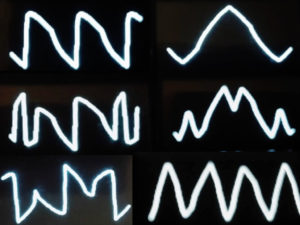Synth engine
The KORG monologue feature a quite standard subtractive synth engine but with some clever additional sound design features.
Oscillators
The whole engine is based on two analog oscillators that can be accessed independently in detail. Oscillator 1 comes with a saw, triangle and pulse/square waveform. All three waveforms have in my opinion a solid and good sound quality. They have not a super clean sound character but comes with a nice different analog charm. The oscillators of the monologue can’t be described as standard due of a deeper shaper function that makes them very versatile. This unique shape function distort and bend the waveforms in a very beautiful way. Basically, you add harmonics to the initial waveforms.

In my full video review, you can hear in detail how beautifully the basic waveforms can deform and how quickly you can produce and design new timbres with it. The shape function works a bit different in the pulse/square waveform. Here the shape function works under a wrong name and is actually a classical pulse width modulation. When you turn up the shape function completely,the pulse waveform is path. That is quite interesting to observe because in many synths something remains left over. One downside in oscillator 1 is the static behaviour due of no additional pitch or octave function.
Oscillator 2 features a saw, triangle waveform and a noise generator. Same as in the oscillator 1, it allows users to apply the unique shaping feature for adding instant new timbres to them. Unlike oscillator 1, the second sound generator comes with an octave slider that goes from 16 to 2 and a pitch knob with a range from -1200 to + 1200. The noise generator doesn’t support here any shape function. Both oscillators can be changed on the left side of the interface in two octaves to the left and to the right. To get the best overview how both oscillators sounds when shaping is applied, I recommend to check out minute 7 of my monologue review video.
Beside both instances of shaping, the oscillators offers two other interesting sound design functions which makes the device even more versatile. First, you can sync both oscillators that provoke that one oscillator will restart the period of another oscillator, so that they will have the same base frequency. With this, you can create per example very dominant sync typ lead sounds.

Than you have also an addition ring modulation function. By applying it to the initial oscillator sound of the monologue, the sound character becomes much harsher, colder and get kind of metallic timbre in my opinion.
In overall, one can say that the oscillators of the KORG monologue are very special and offer plenty of playroom for new sounds. Especially the shape function (for each oscillator & sync, ring mod) offers a lot of different sonic possibilities. More advanced and crazy sonic timbres, you can achieve when you route the shaper function to the internal LFO that can go easily in the audio rate.
Filter
Both oscillators travel then further into a simple mixer with two knobs. This signal goes than in a new designed 2 pole /12 dB per octave low pass filter. The filter is my opinion very direct and has a nice acid character. That’s maybe one of the reasons why Aphex Twin liked the synth very much for creating sounds. You can find in the factory preset library cool acid oriented presets designed by Aphex Twin.

This new 2 pole low pass filter can also very nice self oscillator what is perfect for designing unique percussive sounds. Check below my tutorial how you can design percussive sounds with the self-oscillator filter inside the monologue.
The filter can than also be modulated by a mod envelope or by an LFO on the right side. If you modulate the filter with the slow or fast LFO mode, you can achieve very quick audio rate modulation as well as FM filter sounds. To get an idea how fast the LFO can go, check also my full video review of the monologue.

1 Trackback / Pingback